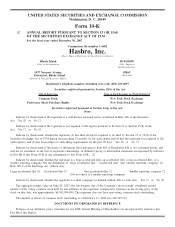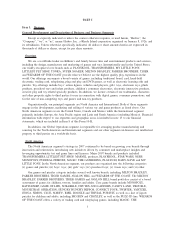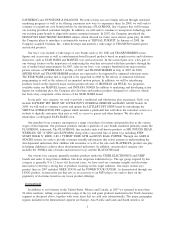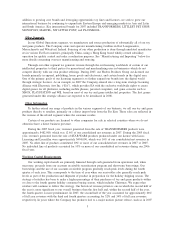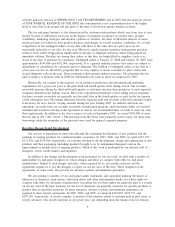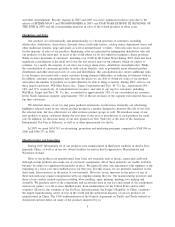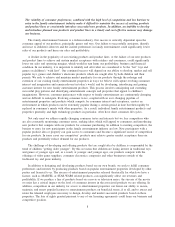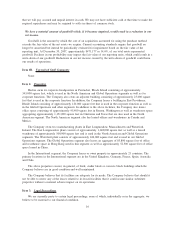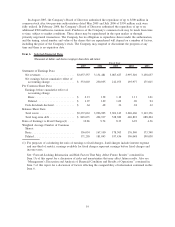Hasbro 2007 Annual Report Download - page 17
Download and view the complete annual report
Please find page 17 of the 2007 Hasbro annual report below. You can navigate through the pages in the report by either clicking on the pages listed below, or by using the keyword search tool below to find specific information within the annual report.There is no guarantee that:
• Any of our current products or product lines will continue to be popular;
• Any property for which we have a significant license will achieve or sustain popularity;
• Any new products or product lines we introduce will be considered interesting to consumers and
achieve an adequate market acceptance;
• Any new product’s life cycle will be sufficient to permit us to profitably recover development,
manufacturing, marketing, royalties (including royalty advances and guarantees) and other costs of
producing and selling the product; or
• We will be able to manufacture, source and ship new or continuing products in a timely and cost-
effective basis to meet constantly changing consumer demands, a risk that is heightened by our
customers’ compressed shipping schedules and the seasonality of our business.
In developing new products and product lines, we have anticipated dates for the associated product
introductions. When we state that we will introduce, or anticipate introducing, a particular product or product
line at a certain time in the future those expectations are based on completing the associated development and
implementation work in accordance with our currently anticipated development schedule. Unforeseen delays or
difficulties in the development process, or significant increases in the planned cost of development, may cause
the introduction date for products to be later than anticipated or, in some situations, may cause a product
introduction to be discontinued. Similarly, the success of our products is often dependent on the timelines and
effectiveness of related advertising and media efforts. Television programming, movie and DVD releases,
comic book releases, and other media efforts are often critical in generating interest in our products. Not only
our efforts, but the efforts of third parties, heavily impact the launch dates and success of these media efforts.
When we say that products or brands will be supported by certain media releases, those statements are based
on our current plans and expectations. Unforeseen factors may delay these media releases or even lead to their
cancellation. Any delay or cancellation of planned product development work, introductions, or media support
may decrease the number of products we sell and harm our business.
Our business is seasonal and therefore our annual operating results will depend, in large part, on our
sales during the relatively brief holiday shopping season. This seasonality is exacerbated as retailers
become more efficient in their control of inventory levels through quick response inventory management
techniques.
Sales of our family entertainment products at retail are extremely seasonal, with a majority of retail sales
occurring during the period from September through December in anticipation of the holiday season, including
Christmas. This seasonality has increased over time, as retailers become more efficient in their control of
inventory levels through quick response inventory management techniques. These customers are timing their
orders so that they are being filled by suppliers, such as us, closer to the time of purchase by consumers. For
toys, games and other family entertainment products which we produce, a majority of retail sales for the entire
year occur in the fourth quarter, close to the holiday season. As a consequence, the majority of our sales to
our customers occur in the period from September through December, as our customers do not want to
maintain large on-hand inventories throughout the year ahead of consumer demand. While these techniques
reduce a retailer’s investment in inventory, they increase pressure on suppliers like us to fill orders promptly
and thereby shift a significant portion of inventory risk and carrying costs to the supplier.
The limited inventory carried by retailers may also reduce or delay retail sales, resulting in lower
revenues for us. If we or our customers determine that one of our products is more popular at retail than was
originally anticipated, we may not have sufficient time to produce and ship enough additional product to fully
capture consumer interest in the product. Additionally, the logistics of supplying more and more product
within shorter time periods increases the risk that we will fail to achieve tight and compressed shipping
schedules, which also may reduce our sales and harm our financial performance. This seasonal pattern requires
significant use of working capital, mainly to manufacture or acquire inventory during the portion of the year
prior to the holiday season, and requires accurate forecasting of demand for products during the holiday season
9


